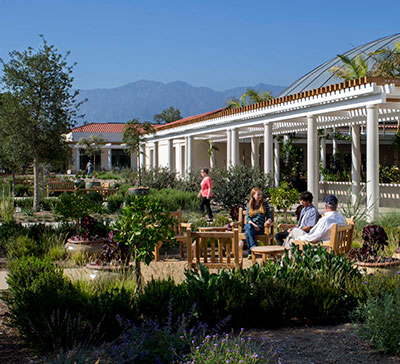Conserving Water without Sacrificing Beauty

The Brody California Garden at the Huntington Library provides the perfect setting among Mediterranean climate landscape.
Scott Kleinrock, educator, horticulturist, and landscape designer, spoke to the San Diego Horticultural Society in April. He is currently a conservator manager at the Chino Basin Water Conservation District in San Bernardino where he works on creating a culture of sustainable water use through demonstrations and education. He has also worked as a landscape planning coordinator at the Huntington Library and the Botanical Gardens where he led the planting design of the Brody, California Garden, a six and a half acre of Mediterranean climate landscape. He dispelled some myths about San Diego’s climate and gave us ideas to create a beautiful garden without using excessive amounts of water by using plants naturally adapted to our regional conditions.
San Diego is not a desert, according to Kleinrock. It is a semi-arid Mediterranean climate. Low water use is not a compromise. He says, “The drought opened an opportunity for a new landscape ethic, ‘What does it do?’”
He says both native and adapted gardens provide human comfort, beauty, scent, food and a place to live for native insects, birds, and reptiles. Soils become healthier and absorb rain water, and gardens give us “a sense of place,” Kleinrock says.
A garden provides a connection between us and our world. Gardens provide life-long learning while inspiring us and helping us to restore ourselves and our focus. Kleinrock suggests that we “envision our gardens.” He says a garden is not just collections of plants, but “a living ecosystem.” He calls a garden a “process” since it is never finished; it is changing constantly.
According to Kleinrock, if you think of your garden this way, it is “liberating, more fun, and much more interesting.” He went on to say that “it becomes based in a larger world of natural science, giving us a way to ‘root’ our designs and actions in the garden.”
Inspired by adapted plant communities, Kleinrock wants something that will look good, survive without humans’ slavery, and that will withstand both drought and wet years. Scientists tell us that from tree rings’ evidence, during the Middle Ages our American West went through two major drought periods, each lasting close to 200 years. He showed us a chart showing that, with a few exceptions, it has been wetter than normal since about 1500 with the 20th century being especially wet.
Two important considerations when planning a garden are plant density and what is on the ground. This means that soil type and climate determine which species will thrive and where. With this knowledge, you can more quickly create a successful garden.
Many drought tolerant plants need little water and no fertilizer or compost. Kleinrock says, “The art is assembling the right plants in the right patterns.”
This means considering the plants’ requirement for sun or shade, for what kind of drainage and soil type, for how much water they need and how often, and how they grow and at what rate. Some plants can overtake a garden in a few years. Others grow very slowly. Some require extra space or even a trellis.
Drip irrigation makes controlling each niche’s water allotment easier. This is why it is so important to put plants with similar needs together.
Kleinrock quoted Aristotle who said “Nature abhors a vacuum.” He says this means, “If you don’t want to spend a bunch of time weeding, plant your entire garden.” He recommends choosing a few plants for each “niche” or area where those plants will thrive. Consider your design: will you have a layered look, a composed look, grouped plants, or plants put in at random. Of course you may choose all or some of these ideas.
A water feature will encourage pollinators and interesting creatures to stay in your yard.
To illustrate his ideas on a large scale, Scott showed photographs of The Brody California Garden at the Huntington Library. This is the six and one half acre Mediterranean garden he worked on. He showed us plans of the gardens and then showed it under construction. He followed this with a history of his parents’ Van Nuys home so we could see the premise is the same. Working from a plan, he marked the ground showing where paths would be. He also set the plants where they would be living.
Kleinrock summarized what he feels is important when creating a beautiful but low water use garden. He suggests figuring out and focusing on your goals. What is this space to do? How should it feel? Using those goals to create or adapt your plant community and to “design and instigate an ecosystem while considering cycles of water and nutrients. Remember to manage your garden as a system, not a bunch of plants.
We do not meet in July or August. Next month, however, I will write about creative ways to use succulents based on a talk given by Laura Eubanks.
Category: Life Style, National News







